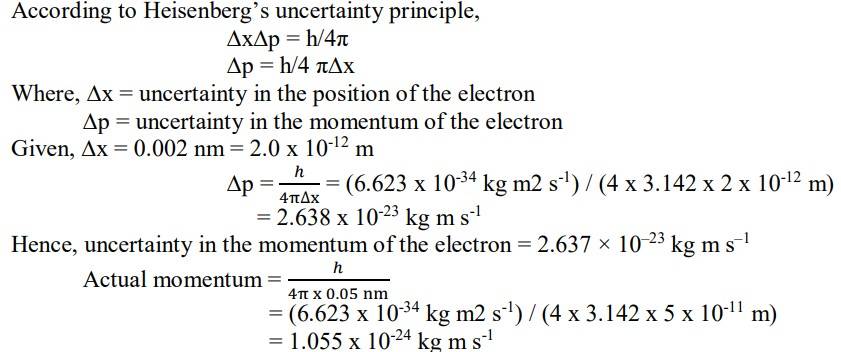Structure of Atoms
Get insights from 148 questions on Structure of Atoms, answered by students, alumni, and experts. You may also ask and answer any question you like about Structure of Atoms
Follow Ask QuestionQuestions
Discussions
Active Users
Followers
New answer posted
3 months agoContributor-Level 10
Configuration of the two elements are:
Al (Z = 13): [Ne]103s23p1
Si (Z = 14): [Ne]103s23p2
The unpaired electrons in silicon (Si) will experience more effective nuclear charge because the atomic number of the element Si is more than that of Al.
New answer posted
3 months agoContributor-Level 10
Greater the penetration of the electron present in a particular orbital towards the nucleus more will be the magnitude of the effective nuclear charge. Based upon this
(i) 2s orbital is closer to the nucleus than 3s orbital and hence it will experience more effective nuclear charge.
(ii) 4d orbital will experience more effective nuclear charge due to its closer proximity to 4f orbital.
(iii) 3p orbital will experience more effective nuclear charge as it is closer to the nucleus
New answer posted
3 months agoContributor-Level 10
The nuclear charge experienced by electrons depends on the distance between the nucleus and orbital. The greater is this distance, the lesser is the effective nuclear charge. Among all the p orbitals, 4p orbital lies the farthest from the nucleus and thus experiences the lowest effective nuclear charge because of the maximum magnitude of screening or shielding effect.
New answer posted
3 months agoContributor-Level 10
The electrons may be assigned to the following orbitals :
(i) 4d
(ii) 3d
(iii) 4p
(iv) 3d
(v) 3p
(vi) 4p.
The increasing order of energy is :
(v) < (ii) = (iv) < (vi) = (iii) < (i)
New answer posted
3 months agoContributor-Level 10

Since actual momentum is smaller than the uncertainty in measuring momentum, therefore, the momentum of electron cannot be defined
New answer posted
3 months agoContributor-Level 10
ν = 4.37 x 105 m s-1, m = 0.1 kg
As per de Brogile's equation,
λ= m/v = (6.626 x 10-34 kg m2 s-1) / (0.1 kg) x (4.37 x 105 m s-1)
=6.626/0.437 x 10-34-5 m
= 1.516 x 10-38 m
New question posted
3 months agoNew answer posted
3 months agoContributor-Level 10
ν = 2.19 x 106 m s-1
As per de Brogile's equation,
λ= m/v = (6.626 x 10-34 kg m2 s-1) / (9.1 x 10-31 kg) x (2.19 x 106 m s-1)
6.626/91 * 2.19= x 10-34+25 m = 0.33243 x 10-9 m = 332.43 pm
New answer posted
3 months agoContributor-Level 10
λ = 800 pm = 800 x 10-12 m
m = 1.675 x 10-27 kg
As per de Brogile's equation,
ν =h/mλ = (6.626 x 10-34 kg m2 s-1) / (1.675 x 10-27 kg) x (800 x 10-12 m)
=6.626/1.675 * 8 x 10-34+27+10
= 0.494 x 103 ms-1
= 494 ms-1
New answer posted
3 months agoContributor-Level 10
As per de Brogile's equation,
λ = h / mv = (6.626 x 10-34 kg m2 s-1) / (9.1 x 10-31 kg) x (1.6 x 106 ms-1)
= 0.455 x 10-9 m = 0.455 nm = 455 pm.
Taking an Exam? Selecting a College?
Get authentic answers from experts, students and alumni that you won't find anywhere else
Sign Up on ShikshaOn Shiksha, get access to
- 65k Colleges
- 1.2k Exams
- 687k Reviews
- 1800k Answers
